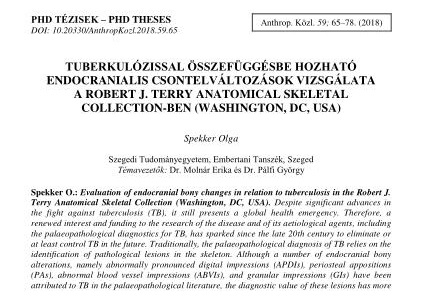Tuberkulózissal összefüggésbe hozható endocranialis csontelváltozások vizsgálata a Robert J. Terry Anatomical Skeletal Collection-ben (Washington, DC, USA)
Absztrakt
Despite significant advances in the fight against tuberculosis (TB), it still presents a global health emergency. Therefore, a renewed interest and funding to the research of the disease and of its aetiological agents, including the palaeopathological diagnostics for TB, has sparked since the late 20th century to eliminate or at least control TB in the future. Traditionally, the palaeopathological diagnosis of TB relies on the identification of pathological lesions in the skeleton. Although a number of endocranial bony alterations, namely abnormally pronounced digital impressions (APDIs), periosteal appositions (PAs), abnormal blood vessel impressions (ABVIs), and granular impressions (GIs) have been attributed to TB in the palaeopathological literature, the diagnostic value of these lesions has more recently been questioned, as their precise aetiology is still a matter of controversy, and similar or even the same morphological features can be found in non-TB-related cases. In the last three decades, the Terry Collection has been used to define and refine palaeopathological diagnostic criteria for TB, however, the possible TB-associated endocranial alteration types were beyond the scope of the aforementioned research projects.
To expand our knowledge and understanding about the development of the four probable TB-related endocranial alteration types and to improve their palaeopathological interpretation, as well as to contribute to strengthening their diagnostic value in the identification of TB in human osteoarchaeological material, a detailed investigation was performed on all individuals recorded to have died of TB in the Terry Collection (TB group), and on a control group consisting of randomly selected specimens from the remaining skeletons of the Terry Collection, identified to have died of causes other than TB (NTB group). The evaluation of the selected skeletons focused on the macromorphological characteristics and on the frequencies of the possible TB-associated endocranial alteration types, as well as of their co-occurrence with each other and with non-endocranial bony changes probably related to TB.
All the examined endocranial alteration types, as well as their association with each other and with non-endocranial lesions occurred significantly more frequently in the TB group compared to the NTB group; therefore, all of them can be used as diagnostic criteria for TB in the palaeopathological practice, especially when they simultaneously occur with each other and/or with probable TB-related non-endocranial bony changes. Our findings fit in with those of previous studies concerning the specificity of the examined lesions: APDIs, PAs, and ABVIs cannot be considered as pathognomonic features of TB and have a weaker diagnostic value compared to GIs, which are TB-specific alterations. In summary, our results contribute to facilitating the establishment of a more reliable and accurate palaeopathological diagnosis of TB.




